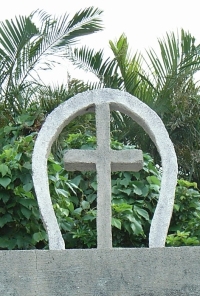Lucky Horseshoe Cross


The Horseshoe Cross appears in several forms: a cross inside a horseshoe with the open ends pointing up or pointing down, a horseshoe hanging on a cross, a cross made from several horseshoes, or any other variation. It is a cross, but the eye cannot help focusing on the horseshoe.
The meaning of the Cross is well documented on this site and elsewhere. Here, we'll look at the meaning of the horseshoe, and why it should be associated with a Christian cross. But first, let's look at other uses of the horseshoe:
Equine Hoofwear

Horseshoes are used for a variety of purposes (for example hoopla) but the main purpose is for shoeing horses. Like human shoes, a horseshoe protects from injury and everyday wear and tear. The days of the traditional blacksmith, hammering white-hot iron on an anvil, are all but over. Today's horseshoes are usually made from steel or aluminium.
Thousands of years ago, as horses became domesticated animals, their lifestyle changed – in particular, their diet. This had an adverse effect on the durability of their hooves and made horses prone to problems such as laminitis. So it wasn't long after domestication began that owners started doing something to protect the feet of their assets; first with strap-on sandals and later with nailed-on iron shoes.
Lucky horseshoe

Not all arcs are horseshoes. This one for example, atop a Christian tomb in Okinawa, is simply a cross enshrined within a curved frame.
Faeries (the rather unpleasant Celtic goblins who steal thimbles, babies and old folk) don't like iron. The factual accuracy of that depends on whether you believe in faeries. But the logic goes that these ancient little people of the Stone Age with their flint arrows, were overrun by nasty invaders with iron weapons. So in Fairy lore, iron is bad news. An iron horseshoe on your door is a convenient way to ward off these bothersome beings. (Incidentally, the word 'faeries' sounds a bit like 'ferrarius', the Latin for iron. Now isn't that ironic!)
There's nothing in the history books to suggest that people who hung a horseshoe on their door suffered mysterious disappearances of thimbles, babies or old folk, so it must have been a good idea. And the horseshoe has since become general-purpose good luck charm.
Some believe that the orientation of the horseshoe is important. Apparently, good luck flows from the ends of a horseshoe, so if these are pointing downwards, then the good luck will drain away. However, in some cultures, the opposite is believed – the downward pointing ends ensure good luck pours into the owner.
And it is the owner who benefits. If a horseshoe is stolen or borrowed (both common events?), good luck will go to the rightful owner. If a horseshoe is found, then the finder becomes the rightful owner. Also, for it to yield good luck, a horseshoe must have been used by a horse. (Because...?)
Corollary: If you buy a nice new silver lucky horseshoe from a jewellery store, the only good fortune will be to the store.
Weddings
John Newton's The Assyrian Grove and other emblems suggests that the horseshoe represents a palm tree, which in turn represents fertility. But the logic of that is not so clear. – If we wanted to use such a fertility symbol for a wedding, we'd probably see a palm tree rather than a horseshoe.
Sparkling horseshoe decorations at weddings are unlikely to provide much 'good luck'. As mentioned above, for good luck to pour out, a horse must first have used the shoe. These tend to be rusty and dirty – not the sort of thing to decorate a wedding cake with. And as for protecting babies and old folk, newlyweds are 'not supposed' to have any babies yet, and usually they are not old folks.
It's easy to make a connection between horseshoe and horse, horse and groom, groom and bride, bride and bridle. But etymologically, there is little or no connection. (See wedding rings)
Equine Christians
Horseshoes with crosses might be imagined as lucky charms with a religious blessing for some people, but for Christians a horseshoe is just a frame around the cross symbol of their faith. (Christianity seems to fit well with cowboys – just think of all those country & western Gospel songs.)
A Horseshoe Cross is a convenient way for horse lovers to advertise both their faith and their interest in spending time with God's creatures. There are innumerable farms and stables that cater for like-minded Christians, and these have names like 'Christian Horse Camp'.
Don't be fooled – there are no Christian horses there!
If you're a horse-rider or somebody who likes to gamble on horse races, despite what you might think, horses do not sin. Horses have not descended from Adam, and Christ did not come to this world to save them. Unlike humans, even the most clever or well-trained horse doesn't have the mental capacity to become a Christian (...although we do have a story about a Christian bear!)
A Horseshoe Cross necklace or belt buckle tells people you are a gal or guy from Texas – or at least, a wannabe Texan. It also tells people you have found something better than 'good luck' – it tells people you have found salvation.
Other 'lucky' pages:

